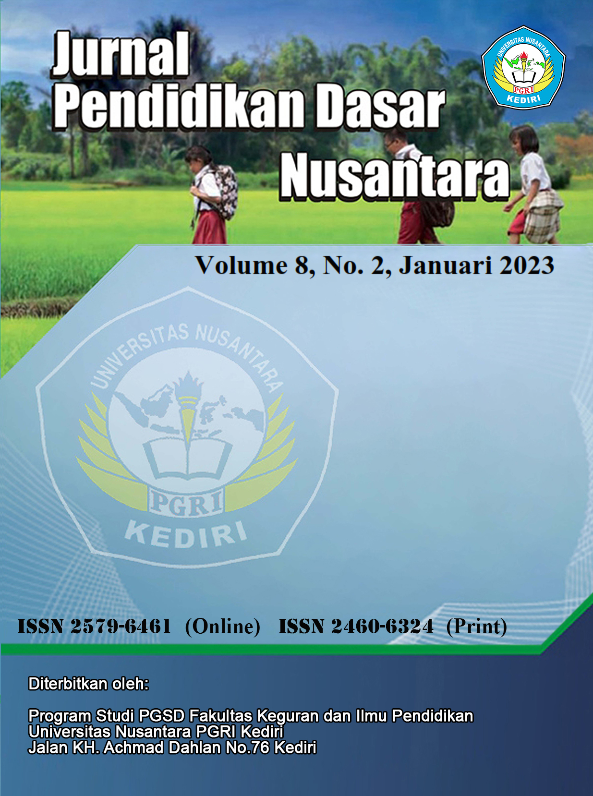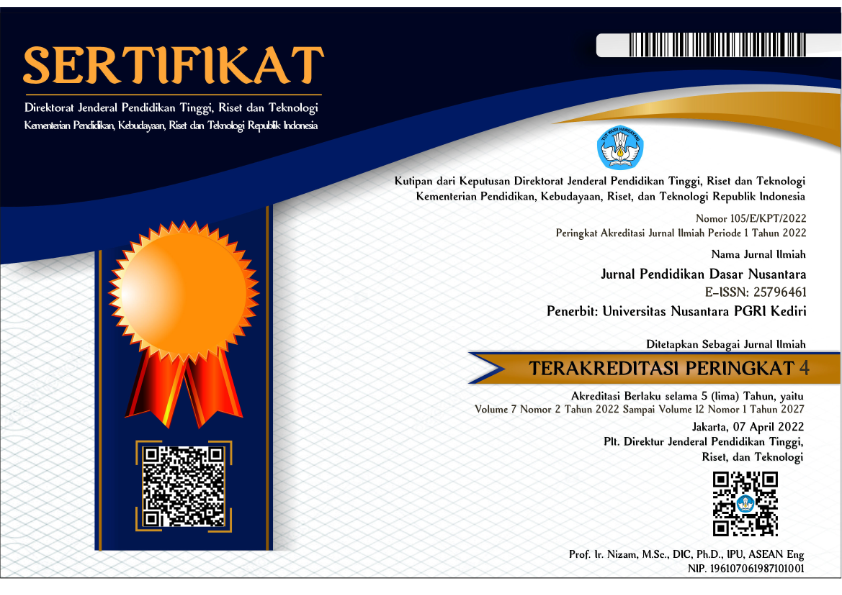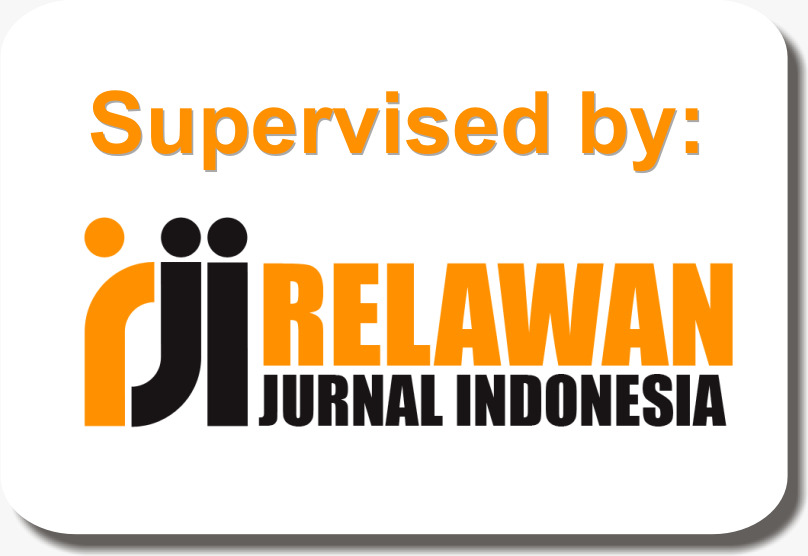Implementation of ethnosains in science learning in madrasah ibtidaiyah
DOI:
https://doi.org/10.29407/jpdn.v8i2.19135Keywords:
Ethnoscience, Science Learning, MadrasahAbstract
The purpose of this study was to analyze and describe science learning based on ethnoscience at MI Darul Ulum Paiton. Ethnoscience learning is the integration of local cultural values into the learning process, especially science subjects.This research uses a descriptive qualitative approach. The research subjects were students of MI Darul Ulum Class IV. The research results show that ethnoscience-based science learning at MI Darul Ulum is carried out in three stages, namely planning, implementation, and evaluation. Planning is carried out routinely at the beginning of the semester by the class teacher. Implementation of learning emphasizes contextual learning. Evaluation is carried out authentically to measure student performance. In addition to measuring the affective, cognitive, and psychomotor domains, morals are the main consideration in the evaluation process.The purpose of this study was to analyze and describe science learning based on ethnoscience at MI Darul Ulum Paiton. Ethnoscience learning is the integration of local cultural values into the learning process, especially science subjects.This research uses a descriptive qualitative approach. The research subjects were students of MI Darul Ulum Class IV. The research results show that ethnoscience-based science learning at MI Darul Ulum is carried out in three stages, namely planning, implementation, and evaluation. Planning is carried out routinely at the beginning of the semester by the class teacher. Implementation of learning emphasizes contextual learning. Evaluation is carried out authentically to measure student performance. In addition to measuring the affective, cognitive, and psychomotor domains, morals are the main consideration in the evaluation process.The purpose of this study was to analyze and describe science learning based on ethnoscience at MI Darul Ulum Paiton. Ethnoscience learning is the integration of local cultural values into the learning process, especially science subjects.This research uses a descriptive qualitative approach. The research subjects were students of MI Darul Ulum Class IV. The research results show that ethnoscience-based science learning at MI Darul Ulum is carried out in three stages, namely planning, implementation, and evaluation. Planning is carried out routinely at the beginning of the semester by the class teacher. Implementation of learning emphasizes contextual learning. Evaluation is carried out authentically to measure student performance. In addition to measuring the affective, cognitive, and psychomotor domains, morals are the main consideration in the evaluation process.The purpose of this study was to analyze and describe science learning based on ethnoscience at MI Darul Ulum Paiton. Ethnoscience learning is the integration of local cultural values into the learning process, especially science subjects.This research uses a descriptive qualitative approach. The research subjects were students of MI Darul Ulum Class IV. The research results show that ethnoscience-based science learning at MI Darul Ulum is carried out in three stages, namely planning, implementation, and evaluation. Planning is carried out routinely at the beginning of the semester by the class teacher. Implementation of learning emphasizes contextual learning. Evaluation is carried out authentically to measure student performance. In addition to measuring the affective, cognitive, and psychomotor domains, morals are the main consideration in the evaluation process.The purpose of this study was to analyze and describe science learning based on ethnoscience at MI Darul Ulum Paiton. Ethnoscience learning is the integration of local cultural values into the learning process, especially science subjects.This research uses a descriptive qualitative approach. The research subjects were students of MI Darul Ulum Class IV. The research results show that ethnoscience-based science learning at MI Darul Ulum is carried out in three stages, namely planning, implementation, and evaluation. Planning is carried out routinely at the beginning of the semester by the class teacher. Implementation of learning emphasizes contextual learning. Evaluation is carried out authentically to measure student performance. In addition to measuring the affective, cognitive, and psychomotor domains, morals are the main consideration in the evaluation process.The purpose of this study was to analyze and describe science learning based on ethnoscience at MI Darul Ulum Paiton. Ethnoscience learning is the integration of local cultural values into the learning process, especially science subjects.This research uses a descriptive qualitative approach. The research subjects were students of MI Darul Ulum Class IV. The research results show that ethnoscience-based science learning at MI Darul Ulum is carried out in three stages, namely planning, implementation, and evaluation. Planning is carried out routinely at the beginning of the semester by the class teacher. Implementation of learning emphasizes contextual learning. Evaluation is carried out authentically to measure student performance. In addition to measuring the affective, cognitive, and psychomotor domains, morals are the main consideration in the evaluation process.
Downloads
References
Andayani, Y., Anwar, Y. A. S., & Hadisaputra, S. 2021. Pendekatan Etnosains dalam Pelajaran Kimia Untuk Pembentukan Karakter Siswa: Tanggapan Guru Kimia di NTB. Jurnal Pijar Mipa, 16(1), 39–43. https://doi.org/10.29303/jpm.v16i1.2269
Anggraeni, P., & Akbar, A. (2018). Kesesuaian rencana pelaksanaan pembelajaran dan proses pembelajaran. Jurnal Pesona Dasar, 6(2).
Anshori, I. 2017. Penguatan Pendidikan Karakter di Madrasah. Halaqa: Islamic Education Journal, 1(2), 63-74., 1(2), 63–74. https://doi.org/10.1016/j.addr.2018.07.012%0Ahttp://www.capsulae.com/media/Microencapsulation - Capsulae.pdf%0Ahttps://doi.org/10.1016/j.jaerosci.2019.05.001
Damayanti, C., Rusilowati, A., & Linuwih, S. (2017). Journal of Innovative Science Education Pengembangan Model Pembelajaran IPA Terintegrasi Etnosains. Journal of Innovative Science Education, 6(1), 116–128.
Dinissjah, M. J., Nirwana, N., & Risdianto, E. (2019). Penggunaan Model Pembelajaran Direct Instruction Berbasis Etnosains Dalam Pembelajaran Fisika Untuk Meningkatkan Kemampuan Berpikir Kritis Siswa. Jurnal Kumparan Fisika, 2(2), 99–104. https://doi.org/10.33369/jkf.2.2.99-104
Fitriyani, N. (2019). Pengembangan Media Pembelajaran Audio-Visual Powtoon Tentang Konsep Diri Dalam Bimbingan Kelompok Untuk Peserta Didik Sekolah Dasar. Jurnal Tunas Bangsa, 6(1), 104–114.
Hadi*, W. P., Munawaroh, F., Rosidi, I., & Wardani, W. K. (2020). Penerapan Model Pembelajaran Discovery Learning Berpendekatan Etnosains untuk Mengetahui Profil Literasi Sains Siswa SMP. Jurnal IPA & Pembelajaran IPA, 4(2), 178–192. https://doi.org/10.24815/jipi.v4i2.15771
Jannah, S. R., & Aisyah, N. (2021). Strategi Pembelajaran Kooperatif (Cooperative Learning) Guru Pendidikan Agama Islam (Pai) Dalam Meningkatkan Kemampuan Hasil …. TA’LIM: Jurnal Studi Pendidikan Islam, 4(1), 42–59. http://www.e-jurnal.unisda.ac.id/index.php/talim/article/view/2181
Mulyani, T., & Armiati, A. (2021). Efektivitas Penggunaan Ensiklopedia Berbasis Teknologi Sebagai Sumber Belajar di Sekolah Menengah Atas (SMA): Literature Review. Jurnal Ecogen, 4(2), 293. https://doi.org/10.24036/jmpe.v4i2.11164
Muzianah, Si. (2017). Upaya Guru Dalam Menginternalisasikan Nilai–Nilai Pendidikan Agama Islam Bagi Pembentukan Akhlakul Karimah Di Sdit As Sunnah Kota Cirebon. OASIS: Jurnal Ilmiah Kajian Islam, 2(1), 66.
Negeri, G. S. (2016). Guru Profesional dan Pembelajaran Bermakna. Jurnal BAPPEDA, 2(1).
Nuralita, A. (2020). Analisis penerapan model Pembelajaran berbasis etnosains dalam pembelajaran tematik SD. MIMBAR PGSD Undiksha, 4(1), 1–8.
Nuralita, A., & Reffiane, F. (2020). Keefektifan Model PBL Berbasis Etnosains Terhadap Hasil Belajar. MIMBAR PGSD Undiksha, 8(3), 457–467. https://ejournal.undiksha.ac.id/index.php/JJPGSD/article/view/28185
Okwita, A., & Sari, S. P. (2019). Eksistensi Permainan Tradisional Egrang pada Masyarakat Monggak Kecamatan Galang Kota Batam. HISTORIA: Journal of Historical Education Study Program, 4(1), 19–33.
Parmin, P., dkk. (2017). Science integrated learning model to enhance the scientific work independence of student teacher in indigenous knowledge transformation. Jurnal Pendidikan IPA Indonesia, 6(2), 365–372.
Pertiwi, U. D., & Firdausi, U. Y. R. (2019). Upaya meningkatkan literasi sains melalui pembelajaran berbasis etnosains. Indonesian Journal of Natural Science Education (IJNSE).
Pertiwi, U. D., & Rusyda Firdausi, U. Y. (2019). Upaya Meningkatkan Literasi Sains Melalui Pembelajaran Berbasis Etnosains. Indonesian Journal of Natural Science Education (IJNSE), 2(1), 120–124. https://doi.org/10.31002/nse.v2i1.476
Puspasari, A., Susilowati, I., Kurniawati, L., Utami, R. R., Gunawan, I., & Sayekti, I. C. (2019). Implementasi Etnosains dalam Pembelajaran IPA di SD Muhammadiyah Alam Surya Mentari Surakarta. SEJ (Science Education Journal), 3(1), 25–31. https://doi.org/10.21070/sej.v3i1.2426
Rahmawaty, D., Nadiroh, N., Husen, A., & Purwanto, A. (2021). Merajut Sebagai Kegiatan Baru Untuk Terapi Mengurangi Kecemasan Selama Masa Pandemi Covid. Jurnal Review Pendidikan Dan Pengajaran, 4(1), 107–113. https://doi.org/10.31004/jrpp.v4i1.1853
Rubiyanto. (2013). Penelitian Pendidikan Untuk Mahapeserta didik Pendidikan Guru Sekolah Dasar. In Surakarta: Universitas Muhammadiyah Surakarta Press.
Saputro, M. N. A., & Pakpahan, P. L. (2021). Mengukur Keefektifan Teori Konstruktivisme dalam Pembelajaran. JOEAI: Journal of Education and Instruction, 4(1), 24–39.
Sari Kardi, I., & Eko Nopiyanto, Y. (2020). Penerapan aktivitas fungsional rekreasi pada masa new normal untuk menjaga kesehatan lanjut usia The implementation of recreational functional activities in the new normal to maintain the health of the elderly. Pengabdian Dan Bakti, 1(1). https://ejournal.stikesmuhgombong.ac.id/index.php/EMPATI
Satria, T. G., & Egok, A. S. (2020). Pengembangan Etnosains Multimedia Learning Untuk Meningkatkan Kognitif Skill Siswa Sd Di Kota Lubuklinggau. Jurnal Basicedu, 4(1), 13–21. https://doi.org/10.31004/basicedu.v4i1.382
Shawmi, A. N. (2016). Analisis pembelajaran sains madrasah ibtidaiyah (MI) dalam kurikulum 2013. TERAMPIL: Jurnal Pendidikan Dan Pembelajaran Dasar, 3(1), 121–144.
Warsah, I., & Uyun, M. (2019). Kepribadian pendidik: telaah psikologi islami. Psikis: Jurnal Psikologi Islami, 5(1), 62–73.
Yuliana, I., Cahyono, M. E., Widodo, W., & Irwanto, I. (2021). The effect of ethnoscience-themed picture books embedded within contextbased learning on students’ scientific literacy. Eurasian Journal of Educational Research, 2021(92), 317–334. https://doi.org/10.14689/ejer.2021.92.16
Zubaidah, S. (2016). Keterampilan abad ke-21: Keterampilan yang diajarkan melalui pembelajaran. Seminar Nasional Pendidikan, 2(2), 1–17.
Downloads
Published
Issue
Section
License
Authors who publish with this journal agree to the following terms:
- Copyright on any article is retained by the author(s).
- The author grants the journal, the right of first publication with the work simultaneously licensed under a Creative Commons Attribution License that allows others to share the work with an acknowledgment of the work’s authorship and initial publication in this journal.
- Authors are able to enter into separate, additional contractual arrangements for the non-exclusive distribution of the journal’s published version of the work (e.g., post it to an institutional repository or publish it in a book), with an acknowledgment of its initial publication in this journal.
- Authors are permitted and encouraged to post their work online (e.g., in institutional repositories or on their website) prior to and during the submission process, as it can lead to productive exchanges, as well as earlier and greater citation of published work.
- The article and any associated published material is distributed under the Creative Commons Attribution-ShareAlike 4.0 International License

































